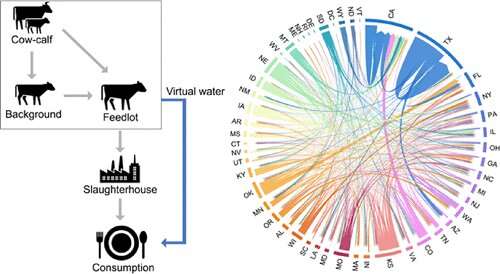Researchers develop a framework to understand water use in beef supply chains from production to consumption

Animal-based products constitute a large portion of the average American's diet, as well as the resources necessary to get them from field to table. But as food systems in the US become more interconnected and complex, what we choose to put on our plates—beef products in particular—often impacts the environment in previously unknown ways.
Water is heavily needed throughout the entire food supply, but the beef industry is the least efficient at using it. University of Pittsburgh researchers have designed a model that reports the industry's impact on virtual water flows—the hidden movement of water in food production—by tracing beef supply chains from calf production to beef consumption at the county level. They report on their work in Environmental Science & Technology.
"Understanding beef demands and the spatial distribution of both feed and cattle production are key for evaluating the environmental sustainability of food systems and developing improvement strategies," said Vikas Khanna, associate professor of civil and environmental engineering and Wellington C. Carl Faculty Fellow at the Swanson School of Engineering.
All animal production requires great quantities of water, with the vast majority used to produce feed. The irrigation process for feed requires blue water, which is water found in surface and ground reservoirs. Using blue water exclusively can lead to significant environmental concerns like water depletion, water logging, salization, and soil degradation.
"To irrigate feed crops for each ton of boneless beef eaten in the US, we found that approximately 3.5 cubic meters of blue water is needed." Anaís Ostroski, lead author and Ph.D. student, said. "That's equivalent to more than 900 gallons of water." (At room temperature, that equals approximately 3.7 tons of water to produce one ton of beef.)
By using an optimization-based framework and publicly available datasets on supply and demand, the model found there is a major disconnect between consumption and production counties, with over 22 billion cubic meters of virtual blue water being transferred in 2017 alone. For perspective, the Great Salt Lake is 19 billion cubic meters.
"Typically, real-world networks have a highly skewed degree of distributions with few highly connected intersections," explained Khanna. "We observed this in our network as the majority of counties have very few connections, while a small number of counties have a large amount of connections."
Khanna and Ostroski are joined by Oleg Prokopyev, professor of industrial engineering, and Tomas Lagos, Ph.D. student in industrial engineering.
The team next plans to apply the developed framework to understand environmental impacts of other animal-based production practices and identify improvement opportunities.
More information: Anaís Ostroski et al, Consumption-Based Accounting for Tracing Virtual Water Flows Associated with Beef Supply Chains in the United States, Environmental Science & Technology (2022). DOI: 10.1021/acs.est.2c03986
Journal information: Environmental Science & Technology
Provided by University of Pittsburgh




















